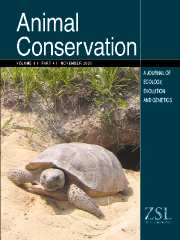Crossref Citations
This article has been cited by the following publications. This list is generated based on data provided by
Crossref.
Parsons, K. N.
and
Jones, G.
2003.
Dispersion and habitat use by Myotis daubentonii and Myotis nattereri during the swarming season: implications for conservation.
Animal Conservation,
Vol. 6,
Issue. 4,
p.
283.
Ellison, Laura E.
Everette, A. Lance
Bogan, Michael A.
and
Edwards, Cody W.
2005.
EXAMINING PATTERNS OF BAT ACTIVITY IN BANDELIER NATIONAL MONUMENT, NEW MEXICO, BY USING WALKING POINT TRANSECTS.
The Southwestern Naturalist,
Vol. 50,
Issue. 2,
p.
197.
Davidson-Watts, Ian
Walls, Sean
and
Jones, Gareth
2006.
Differential habitat selection by Pipistrellus pipistrellus and Pipistrellus pygmaeus identifies distinct conservation needs for cryptic species of echolocating bats.
Biological Conservation,
Vol. 133,
Issue. 1,
p.
118.
Bartonička, Tomáš
Bielik, Andrej
and
Řehák, Zdeněk
2008.
Roost Switching and Activity Patterns in the Soprano Pipistrelle,Pipistrellus pygmaeus, during Lactation.
Annales Zoologici Fennici,
Vol. 45,
Issue. 6,
p.
503.
Jennings, N.
Parsons, S.
and
Pocock, M. J.O.
2008.
Human vs. machine: identification of bat species from their echolocation calls by humans and by artificial neural networks.
Canadian Journal of Zoology,
Vol. 86,
Issue. 5,
p.
371.
2009.
Characterization of the Echolocation Calls of Bats from Exuma, Bahamas.
Acta Chiropterologica,
Vol. 11,
Issue. 2,
p.
415.
Lundy, Mathieu
and
Montgomery, Ian
2010.
Summer habitat associations of bats between riparian landscapes and within riparian areas.
European Journal of Wildlife Research,
Vol. 56,
Issue. 3,
p.
385.
Boughey, Katherine L.
Lake, Iain R.
Haysom, Karen A.
and
Dolman, Paul M.
2011.
Improving the biodiversity benefits of hedgerows: How physical characteristics and the proximity of foraging habitat affect the use of linear features by bats.
Biological Conservation,
Vol. 144,
Issue. 6,
p.
1790.
Fabianek, François
Gagnon, Daniel
and
Delorme, Michel
2011.
Bat distribution and activity in Montréal Island green spaces: Responses to multi-scale habitat effects in a densely urbanized area.
Écoscience,
Vol. 18,
Issue. 1,
p.
9.
Lõhmus, Kertu
and
Liira, Jaan
2013.
Old rural parks support higher biodiversity than forest remnants.
Basic and Applied Ecology,
Vol. 14,
Issue. 2,
p.
165.
Dietz, Markus
Pir, Jacques B.
and
Hillen, Jessica
2013.
Does the survival of greater horseshoe bats and Geoffroy’s bats in Western Europe depend on traditional cultural landscapes?.
Biodiversity and Conservation,
Vol. 22,
Issue. 13-14,
p.
3007.
Szentkuti, S
Bontadina, F
Spada, M
Moretti, M
Zambelli, N
Martinoli, A
and
Arlettaz, R
2013.
Factors underlying migratory bat aggregations in chestnut groves.
Endangered Species Research,
Vol. 21,
Issue. 2,
p.
105.
Mendes, Eduardo S.
Pereira, Maria João Ramos
Marques, Sara F.
and
Fonseca, Carlos
2014.
A mosaic of opportunities? Spatio-temporal patterns of bat diversity and activity in a strongly humanized Mediterranean wetland.
European Journal of Wildlife Research,
Vol. 60,
Issue. 4,
p.
651.
Kalda, Rauno
Kalda, Oliver
Lõhmus, Kertu
and
Liira, Jaan
2015.
Multi-scale ecology of woodland bat the role of species pool, landscape complexity and stand structure.
Biodiversity and Conservation,
Vol. 24,
Issue. 2,
p.
337.
Ancillotto, Leonardo
Tomassini, Alessandra
and
Russo, Danilo
2015.
The fancy city life: Kuhl's pipistrelle, Pipistrellus kuhlii, benefits from urbanisation.
Wildlife Research,
Vol. 42,
Issue. 7,
p.
598.
Kalda, Oliver
Kalda, Rauno
and
Liira, Jaan
2015.
Multi-scale ecology of insectivorous bats in agricultural landscapes.
Agriculture, Ecosystems & Environment,
Vol. 199,
Issue. ,
p.
105.
Peste, Filipa
Paula, Anabela
da Silva, Luís P.
Bernardino, Joana
Pereira, Pedro
Mascarenhas, Miguel
Costa, Hugo
Vieira, José
Bastos, Carlos
Fonseca, Carlos
and
Pereira, Maria João Ramos
2015.
How to mitigate impacts of wind farms on bats? A review of potential conservation measures in the European context.
Environmental Impact Assessment Review,
Vol. 51,
Issue. ,
p.
10.
Korine, Carmi
Adams, Rick
Russo, Danilo
Fisher-Phelps, Marina
and
Jacobs, David
2016.
Bats in the Anthropocene: Conservation of Bats in a Changing World.
p.
215.
Silva de Araújo, Mona Lisa Veríssimo
and
Bernard, Enrico
2016.
Green remnants are hotspots for bat activity in a large Brazilian urban area.
Urban Ecosystems,
Vol. 19,
Issue. 1,
p.
287.
Kowarik, Ingo
Buchholz, Sascha
von der Lippe, Moritz
and
Seitz, Birgit
2016.
Biodiversity functions of urban cemeteries: Evidence from one of the largest Jewish cemeteries in Europe.
Urban Forestry & Urban Greening,
Vol. 19,
Issue. ,
p.
68.


